A Decade of Transformation in Higher Education and Science in Kazakhstan: A Literature and Scientometric Review of National Projects and Research Trends
Abstract
1. Introduction
- RQ1: How have the national projects and research in the field contributed to the enhancement of HES in Kazakhstan over the past decade?
- RQ2: What are the key trends in the field that improved HES in the country in comparison to the global trends?
- RQ3: What are the key themes in the national projects and research that have evolved during 2014–2024?
2. Background
2.1. The Post-Soviet Context
2.2. Major Developments in HES
3. Materials and Methods
3.1. Data Collection from Scopus and Screening
3.2. Content Analysis
3.3. Scientometric Analysis
4. Results and Analysis
4.1. Content Analysis of the Trends in HES
4.1.1. R&D Investment
4.1.2. National Projects in Higher Education
4.1.3. Institutional Research Funding and Commercialization
4.2. Network Analysis: Global and Kazakhstani Research Trends in HES
4.2.1. Network Visualization of the Global Trends in HES
4.2.2. Network Visualization of the Kazakhstani Trends in HES
4.3. Temporal Analysis: Evolution of Research Trends in the HES Sector (2014–2024)
4.3.1. Phase 1: Foundational Reforms and System Modernization (2014–2017)
4.3.2. Phase 2: Capacity Building and Evaluation (2018–2021)
4.3.3. Phase 3: Strategic Expansion, Inclusivity, and Globalization (2022–2024)
5. Discussions
5.1. Insights from the Content Analysis
5.2. Comparative Network Analysis: Kazakhstani and Global Literature
5.3. Thematic Evolution of the HES Sector
5.4. The Study Limitations
6. Conclusions
Author Contributions
Funding
Data Availability Statement
Conflicts of Interest
Abbreviations
| ECTS | European Credit Transfer and Accumulation System |
| GDP | Gross Domestic Product |
| GERD | Gross Domestic Expenditure on Research and Development |
| HES | Higher education and science |
| NU | Nazarbayev University |
| OECD | Organization for Economic Cooperation and Development |
| STEM | Science, Technology, Engineering, and Mathematics |
| R&D | Research and development |
| UNESCO | United Nations Educational, Scientific and Cultural Organization |
Appendix A
| Main Category (Codes) | Subcategories | Description |
|---|---|---|
| 1. National R&D strategy (Code 1) | R&D investment, GDP share, policy priorities, international comparisons | Analysis of Kazakhstan’s R&D spending trends and alignment with global benchmarks |
| 2. Higher education reform programs (Code 2) | Bolashak Program, Bologna Process, Nazarbayev University, strategic plans | Evaluation of key national programs aiming to reform and internationalize higher education |
| 3. Institutional research support (Code 3) | Grant funding, commercialization of research, government programs | Assessment of institutional funding mechanisms and translation of research into practice |
| 4. Research capacity and output (Code 4) | Publication output, international collaboration, research mobility, field distribution | Measurement of research productivity, scientific capacity, and contribution to global science |
| Coder | Researcher 1 | Researcher 2 | Researcher 3 | Agreement |
|---|---|---|---|---|
| Code 1 | ✓ | ✓ | ✓ | Yes |
| Code 2 | ✓ | ✗ | ✓ | No |
| Code 3 | ✓ | ✓ | ✓ | Yes |
| Code 4 | ✓ | ✓ | ✓ | Yes |
| Code | Krippendorff’s Alpha | Interpretation |
|---|---|---|
| Code 1 | 0.82 | Strong Agreement |
| Code 2 | 0.73 | Acceptable Agreement |
| Code 3 | 0.79 | Acceptable Agreement |
| Code 4 | 0.83 | Strong Agreement |
References
- Amirbekova, D., Batkeyev, B., & Bigabatova, M. (2025). Bologna externalities: The effect of joining Bologna process on research collaboration. European Journal of Higher Education, 2025, 2491072. [Google Scholar] [CrossRef]
- Amirbekova, D., Narbaev, T., & Kussaiyn, M. (2022). The research environment in a developing economy: Reforms, Patterns, and challenges in Kazakhstan. Publications, 10(4), 37. [Google Scholar] [CrossRef]
- Avelar, A. B. A., da Silva Oliveira, K. D., & Farina, M. C. (2023). The integration of the Sustainable Development Goals into curricula, research and partnerships in higher education. International Review of Education, 69(3), 299–325. [Google Scholar] [CrossRef]
- Bates, T., Cobo, C., Mariño, O., & Wheeler, S. (2020). Can artificial intelligence transform higher education? International Journal of Educational Technology in Higher Education, 17(1), 42. [Google Scholar] [CrossRef]
- Biloshchytskyi, A., Kuchanskyi, O., Mukhatayev, A., Andrashko, Y., Toxanov, S., Faizullin, A., & Kassenov, K. (2024). Application of time-weighted pagerank method with citation intensity for assessing the recent publication productivity and partners selection in R&D collaboration. Publications, 12(4), 48. [Google Scholar] [CrossRef]
- Bolashak. (2023). Report on bolashak scholarship program. Available online: https://bolashak.gov.kz/ru/godovye-otchety (accessed on 10 May 2025).
- Borrego, M., Foster, M. J., & Froyd, J. E. (2014). Systematic literature reviews in engineering education and other developing interdisciplinary fields. Journal of Engineering Education, 103(1), 45–76. [Google Scholar] [CrossRef]
- Bourdieu, P. (1988). Homo academicus. Stanford University Press. Available online: https://www.sup.org/books/sociology/homo-academicus (accessed on 10 May 2025).
- Chang, Y. C., & Lien, H. L. (2020). Mapping course sustainability by embedding the SDGs inventory into the university curriculum: A case study from national university of Kaohsiung in Taiwan. Sustainability, 12(10), 4274. [Google Scholar] [CrossRef]
- Chankseliani, M., Lovakov, A., & Pislyakov, V. (2021). A big picture: Bibliometric study of academic publications from post-Soviet countries. Scientometrics, 126(10), 8701–8730. [Google Scholar] [CrossRef]
- Gafu, G., Sharplin, E., & Israel, M. (2024). Development, adoption or adaption? Researchers’ attitudes to forging social research ethics policy in Kazakhstan, Kyrgyzstan and Uzbekistan. Journal of Academic Ethics, 1–22. [Google Scholar] [CrossRef]
- Hladchenko, M., & Moed, H. F. (2021). The effect of publication traditions and requirements in research assessment and funding policies upon the use of national journals in 28 post-socialist countries. Journal of Informetrics, 15(4), 101190. [Google Scholar] [CrossRef]
- Imperial, M. T. (2021). Implementation structures: The use of top-down and bottom-up approaches to policy implementation. Oxford Research Encyclopedia of Politics. [Google Scholar] [CrossRef]
- Kangalakova, D., Dzhanegizova, A., Satpayeva, Z. T., Nurgaliyeva, K., & Kireyeva, A. A. (2023). Distribution of knowledge through online learning and its impact on the intellectual potential of PhD students. Journal of Distribution Science, 21(4), 47–56. [Google Scholar] [CrossRef]
- Kataeva, Z., Durrani, N., Izekenova, Z., & Rakhimzhanova, A. (2023). Evolution of gender research in the social sciences in post-Soviet countries: A bibliometric analysis. Scientometrics, 128(3), 1639–1666. [Google Scholar] [CrossRef]
- Kim, E., Ramakrishnan, S., & Chiu, J. L. (2025). Polarization in BRICS and G7: Scopus-indexed journal production trends (2013–2023). Publications, 13(1), 9. [Google Scholar] [CrossRef]
- Kireyeva, A., Kangalakova, D., Kredina, A., Satpayeva, Z., & Urdabayev, M. (2021). Managing research and development process in conditions of economic growth of Kazakhstan: Methods and analysis. Problems and Perspectives in Management, 19(3), 185–196. [Google Scholar] [CrossRef]
- Kozhakhmetova, A., Mamyrbayev, A., Zhidebekkyzy, A., & Bilan, S. (2024). Assessing the impact of artificial intelligence on project efficiency enhancement. Knowledge and Performance Management, 8(2), 109–126. [Google Scholar] [CrossRef]
- Krippendorff, K. (2019). Content analysis: An introduction to its methodology. SAGE Publications, Inc. [Google Scholar] [CrossRef]
- Kudaibergenova, R., Uzakbay, S., Makanova, A., Ramadinkyzy, K., Kistaubayev, E., Dussekeev, R., & Smagulov, K. (2022). Managing publication change at Al-Farabi Kazakh National University: A case study. Scientometrics, 127(1), 453–479. [Google Scholar] [CrossRef]
- Kuzhabekova, A. (2021). Development and transformation of doctoral education in Kazakhstan. In M. Yudkevich, P. G. Altbach, & H. de Wit (Eds.), Trends and issues in doctoral education: A global perspective (pp. 340–362). SAGE Publications Pvt Ltd. [Google Scholar] [CrossRef]
- Kuzhabekova, A., Ispambetova, B., Baigazina, A., & Sparks, J. (2022). A critical perspective on short-term international mobility of faculty: An experience from Kazakhstan. Journal of Studies in International Education, 26(4), 454–471. [Google Scholar] [CrossRef]
- Kuzhabekova, A., & Ruby, A. (2018). Raising research productivity in a post-soviet higher education system: A case from Central Asia. European Education, 50(3), 266–282. [Google Scholar] [CrossRef]
- Lodhi, I., & Ilyassova-Schoenfeld, A. (2023). The bologna process and its impact on the higher education reforms in Kazakhstan: A case of policy transfer and translations. Studies in Higher Education, 48(1), 204–219. [Google Scholar] [CrossRef]
- Lovakov, A., Panova, A., & Yudkevich, M. (2022). Global visibility of nationally published research output: The case of the post-Soviet region. Scientometrics, 127(5), 2643–2659. [Google Scholar] [CrossRef]
- Lovakov, A., & Yudkevich, M. (2021). The post-soviet publication landscape for higher education research. Higher Education, 81(2), 273–299. [Google Scholar] [CrossRef]
- Matveeva, N., Batagelj, V., & Ferligoj, A. (2023). Scientific collaboration of post-soviet countries: The effects of different network normalizations. Scientometrics, 128(8), 4219–4242. [Google Scholar] [CrossRef]
- Merrill, M. (2020). Differences in international accreditation: Kyrgyzstan and Kazakhstan. Asian Education and Development Studies, 9(4), 465–478. [Google Scholar] [CrossRef]
- Merton, R. (1973). The normative structure of science. In The sociology of science: Theoretical and empirical investigations (Issue 13, pp. 267–278). University of Chicago Press. Available online: https://press.uchicago.edu/ucp/books/book/chicago/S/bo28451565.html (accessed on 18 May 2025).
- Movkebayeva, Z., Khamitova, D., Zholtayeva, A., Balmagambetova, V., & Balabiyev, K. (2020). Factors influencing the legal regulation and management of education system in Kazakhstan: A review and analysis. Problems and Perspectives in Management, 18(4), 14–24. [Google Scholar] [CrossRef]
- Narbaev, T., & Amirbekova, D. (2021). Research productivity in emerging economies: Empirical evidence from kazakhstan. Publications, 9(4), 51. [Google Scholar] [CrossRef]
- NAS Kz. (2023). National report on science. Available online: https://www.gov.kz/uploads/2023/11/17/7ce8a403d55b7f2b1cb4ab194337832f_original.5055287.pdf (accessed on 18 May 2025).
- Nurtayeva, D., Kredina, A., Kireyeva, A., Satybaldin, A., & Ainakul, N. (2024). The role of digital technologies in higher education institutions: The case of Kazakhstan. Problems and Perspectives in Management, 22(1), 562–577. [Google Scholar] [CrossRef]
- OECD. (2017). Higher education in Kazakhstan 2017 (Reviews of National Policies for Education). OECD. [Google Scholar] [CrossRef]
- OECD. (2019). Reference framework for assessing the scientific and socio-economic impact of research infrastructures (Technology and Industry Policy Papers, Vol. 65). OECD Science. [Google Scholar] [CrossRef]
- OECD. (2020a). Building capacity for evidence-informed policy-making (OECD Public Governance Reviews). OECD. [Google Scholar] [CrossRef]
- OECD. (2020b). Optimising the operation and use of national research infrastructures (Technology and Industry Policy Papers, Vol. 91). OECD Science. [Google Scholar] [CrossRef]
- Römgens, I., Scoupe, R., & Beausaert, S. (2020). Unraveling the concept of employability, bringing together research on employability in higher education and the workplace. Studies in Higher Education, 45(12), 2588–2603. [Google Scholar] [CrossRef]
- Sabatier, P. A. (1986). Top-down and bottom-up approaches to implementation research: A critical analysis and suggested synthesis. Journal of Public Policy, 6(1), 21–48. [Google Scholar] [CrossRef]
- Sagintayeva, A., & Kurakbayev, K. (2015). Understanding the transition of public universities to institutional autonomy in Kazakhstan. European Journal of Higher Education, 5(2), 197–210. [Google Scholar] [CrossRef]
- Siddaway, A. P., Wood, A. M., & Hedges, L. V. (2019). How to do a systematic review: A best practice guide for conducting and reporting narrative reviews, meta-analyses, and meta-syntheses. Annual Review of Psychology, 70, 747–770. [Google Scholar] [CrossRef] [PubMed]
- Singh, E., Vasishta, P., & Singla, A. (2024). AI-enhanced education: Exploring the impact of AI literacy on generation Z’s academic performance in Northern India. Quality Assurance in Education, 33(2), 185–202. [Google Scholar] [CrossRef]
- Smolentseva, A., & Platonova, D. (2023). The transformations of higher education in 15 post-soviet countries: The state, the market and institutional diversification. Higher Education Policy, 36(2), 370–393. [Google Scholar] [CrossRef]
- Statista. (2025). Research and development worldwide. Statistics & Facts. Available online: https://www.statista.com/topics/6737/research-and-development-worldwide/ (accessed on 14 May 2025).
- Thibault, R. T., Amaral, O. B., Argolo, F., Bandrowski, A. E., Davidson, A. R., & Drude, N. I. (2023). Open Science 2.0: Towards a truly collaborative research ecosystem. PLoS Biology, 21(10), e3002362. [Google Scholar] [CrossRef]
- UNESCO. (2025). UIS data browser. Available online: https://databrowser.uis.unesco.org/ (accessed on 1 June 2025).
- Ungureanu, L., Vasilev, A., Prats, G. M., Morselli, A., Nguyen, K., Abraham, E., Bank, J., Leone, S., Todorova, T., Olufunso, F. O., Ebadi, E., Saccal, A., Kucher, L., Neifar, M., Saputra, J., Brady, M. E., Fanea-Ivanovici, M., Altynbassov, B., Metaxas, T., & Fiorenza, E. (2024). Strengthening the nexus: Policy and legislative reforms for university-industry collaboration in Kazakhstan. Theoretical and Practical Research in Economic Fields, 15(1), 136–144. [Google Scholar] [CrossRef]
- Yelibay, M., Karabassova, L., Mukhatayev, Z., & Yermukhambetova, A. (2022). The perception and experience of young researchers in doctoral programmes in the context of recent reforms in Kazakhstan. European Journal of Education, 57(3), 484–496. [Google Scholar] [CrossRef]
- Zhanbayev, R., Sagintayeva, S., Ainur, A., & Nazarov, A. (2020). The use of the foresight methods in developing an algorithm for conducting qualitative examination of the research activities results on the example of the republic of Kazakhstan. Mathematics, 8(11), 2024. [Google Scholar] [CrossRef]
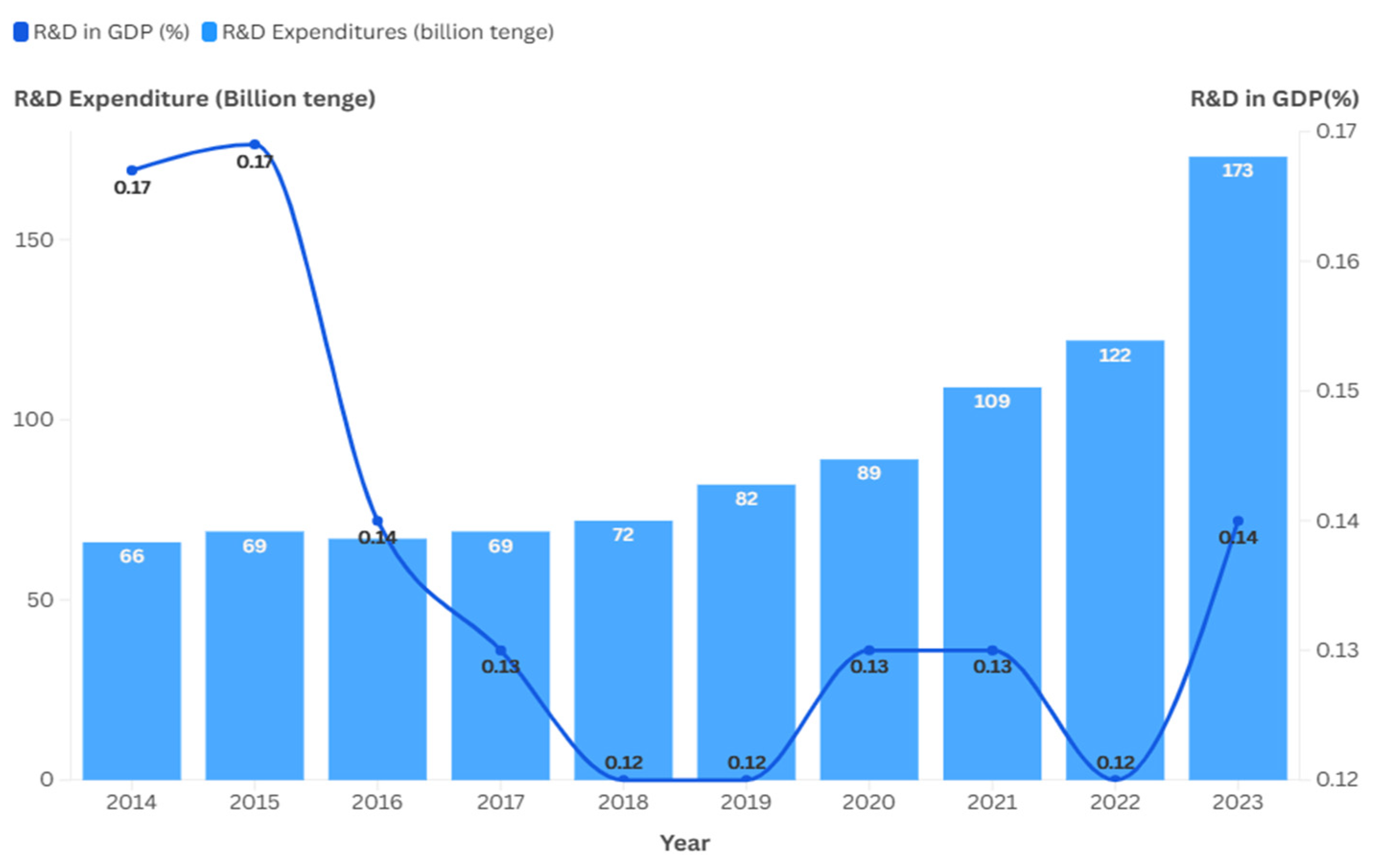
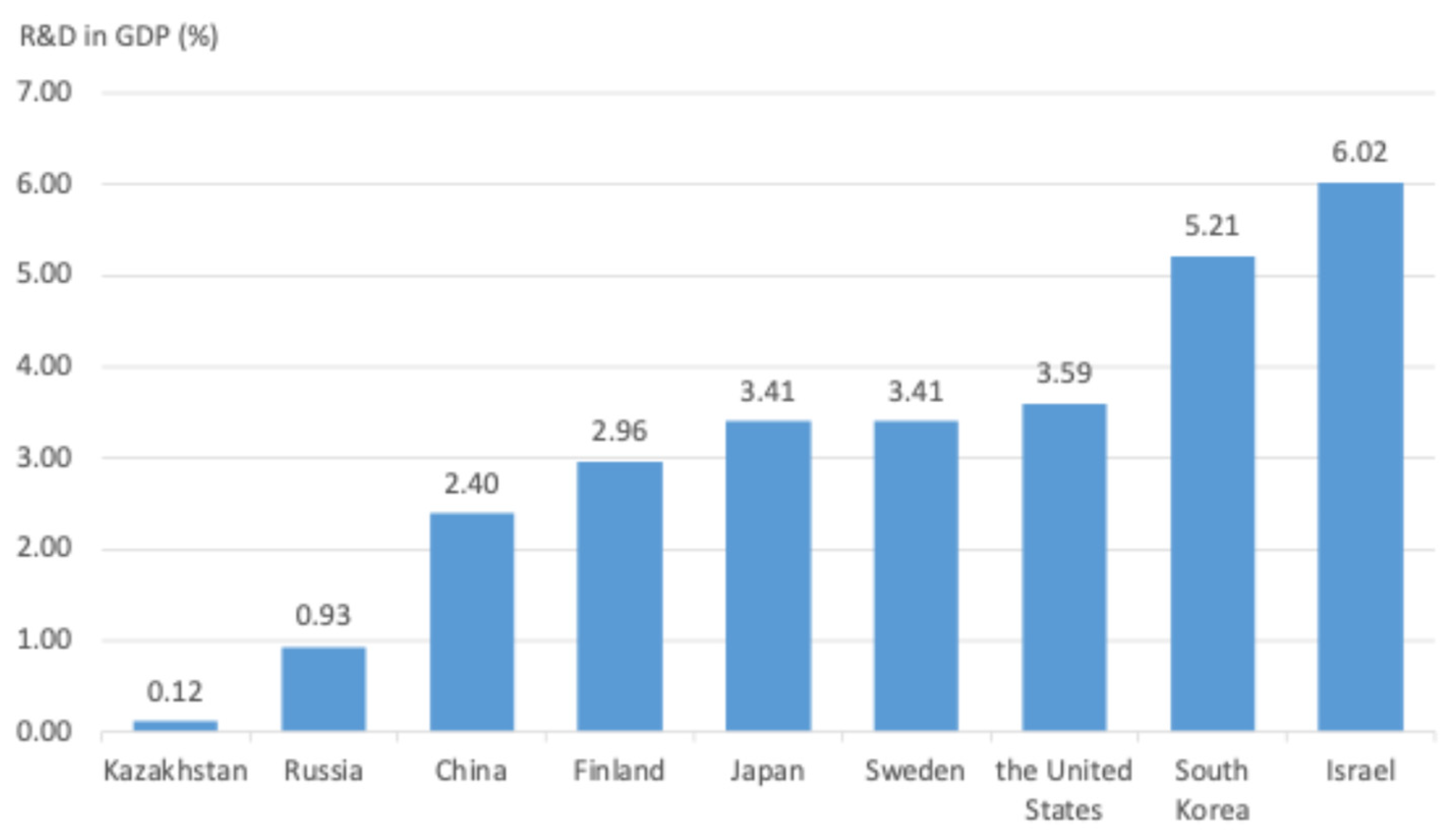
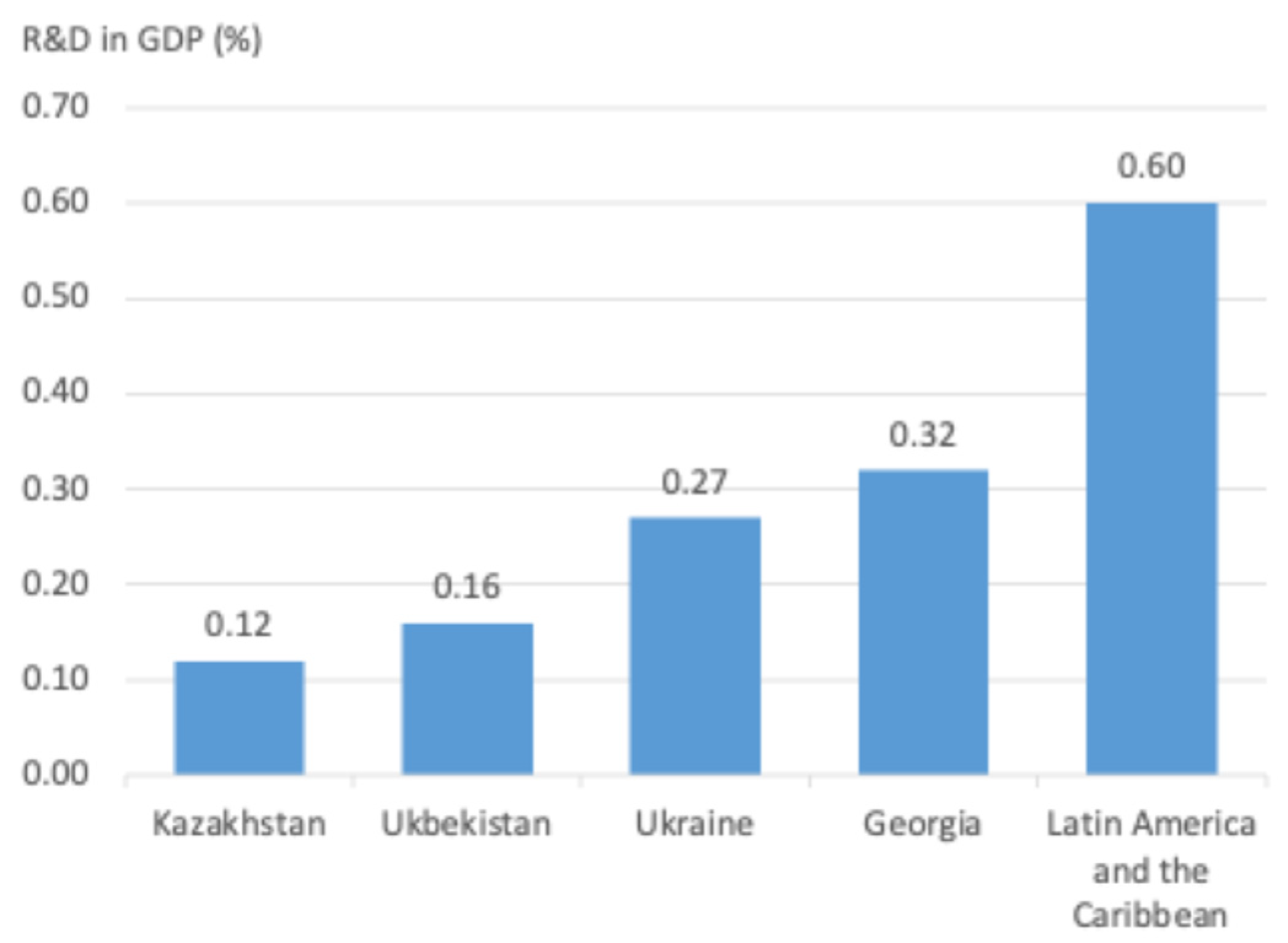
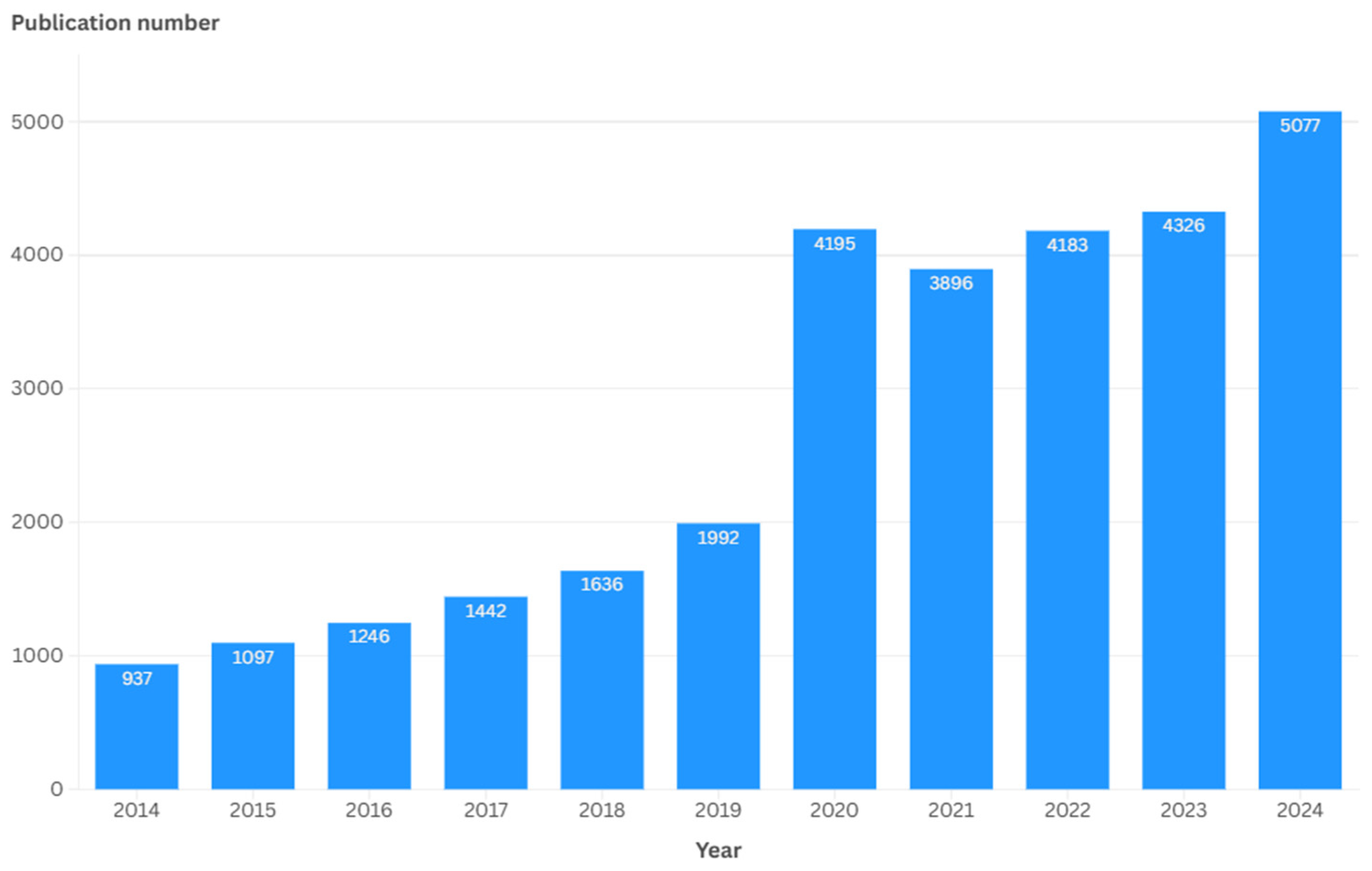
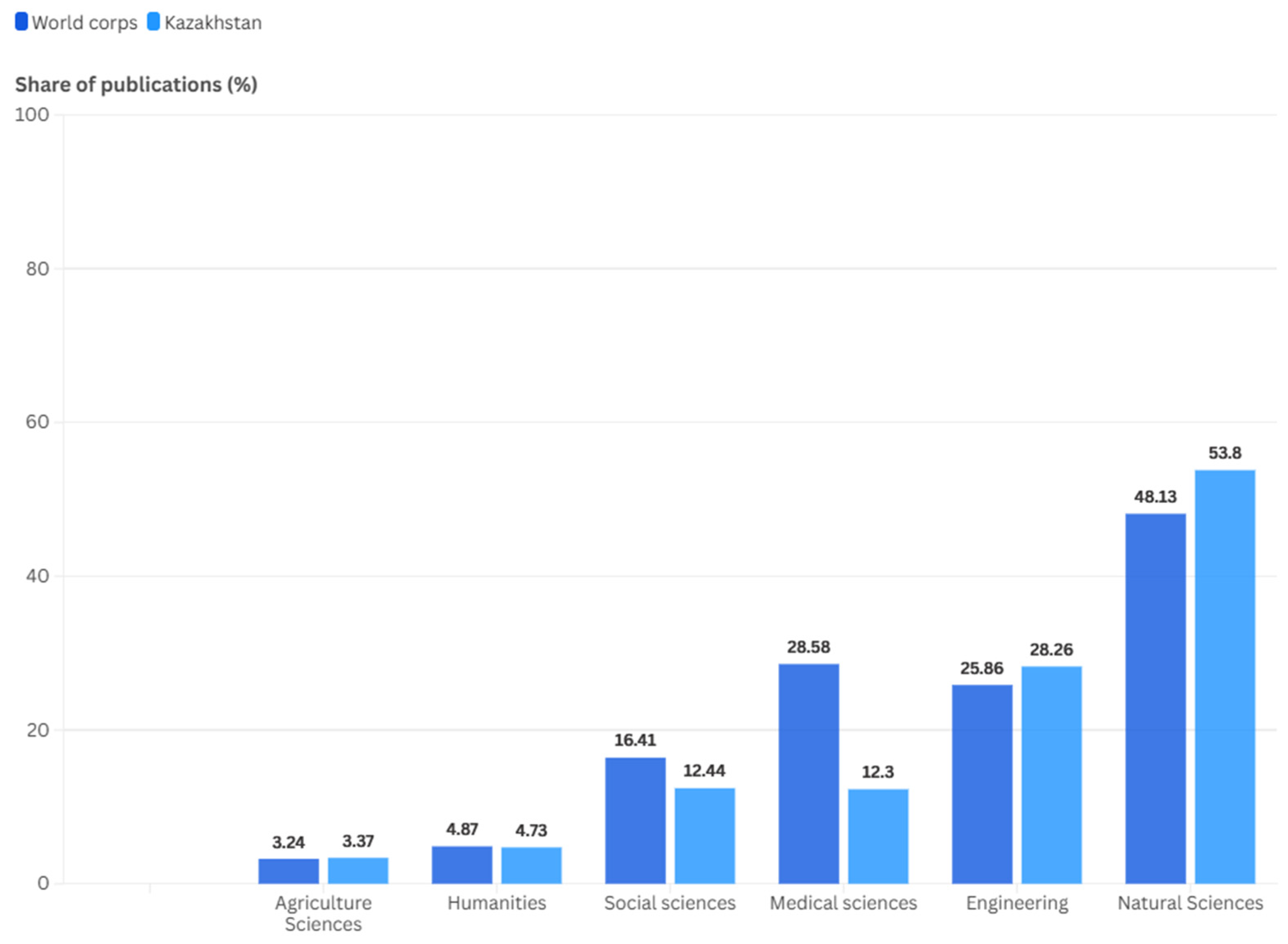
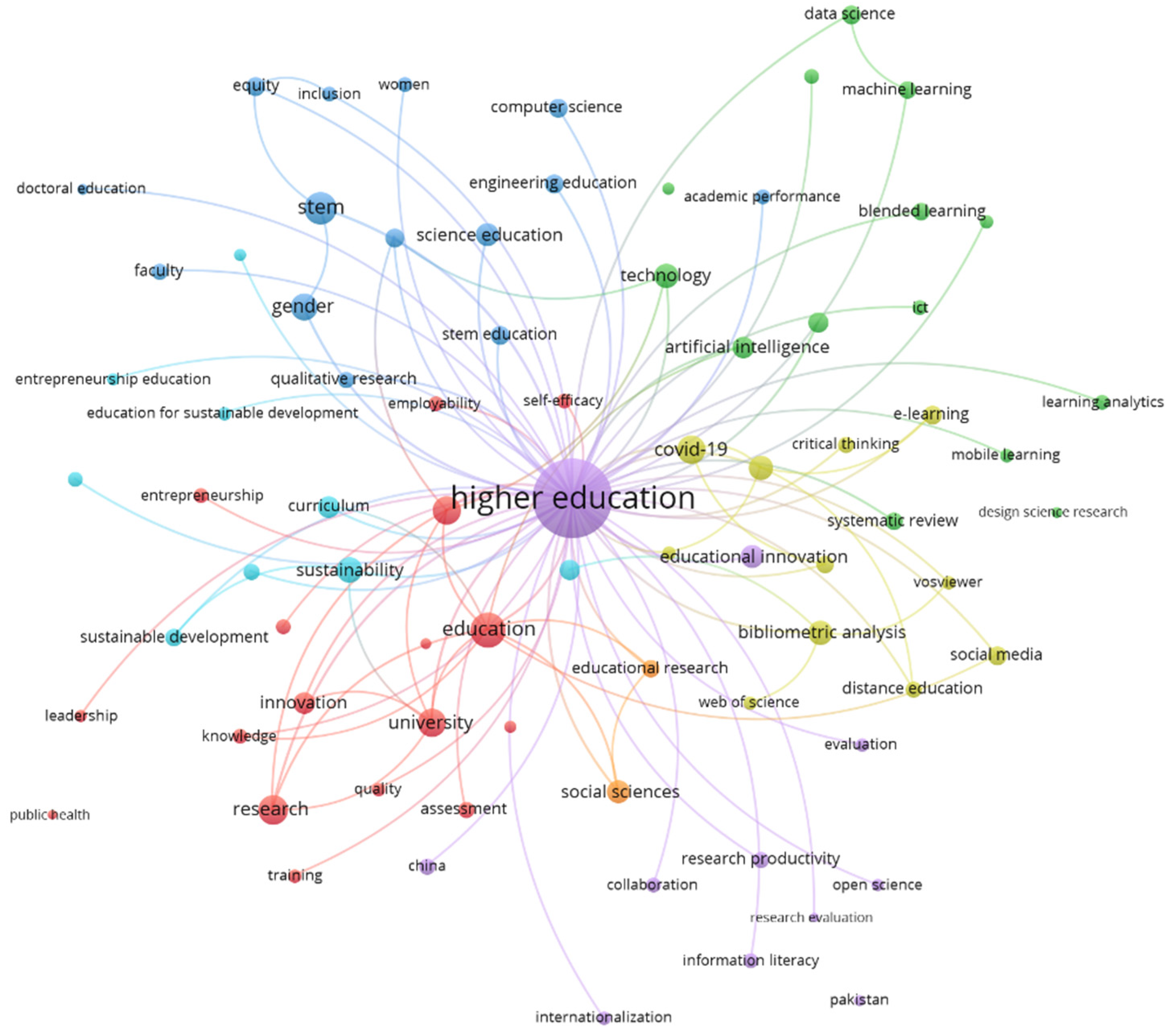


| Steps | Actions and Outputs |
|---|---|
| 1. Data collection and screening | Action: A search was conducted in Scopus using the title, abstract, and keyword fields, with terms such as national projects, initiatives, higher education, science, and research. The data were further filtered to include articles published in English between 2014 and 2024, by country, with Kazakhstan selected to identify relevant national publications. |
| Output: The global search returned a total of 5639 articles. After applying a country-specific filter for Kazakhstan, 75 relevant articles were retrieved. | |
| 2. Content analysis | Action: Review of policy documents, statistics on global and local HES, and academic literature (from Scopus). |
| Output: Provided a comprehensive background on Kazakhstan’s HES landscape and alignment with global benchmarks. Identified key policy initiatives and investment gaps that help explain observed publication patterns and institutional priorities from 2014 to 2024. The analysis responds to our RQ-1. | |
| 3. Scientometric analysis: Network analysis | Action: Keyword co-occurrence mapping was generated in VOSviewer Version 1.6.20 using both global and Kazakhstan-specific academic publications. |
| Output: Keyword cluster maps of the research on HES globally and in Kazakhstan. The analysis responds to our RQ-2. | |
| 4. Scientometric analysis: Temporal analysis | Action: A temporal visualization was generated in VOSviewer using the Kazakhstani dataset to reveal the national focus. |
| Output: A temporal map with three evolution phases of the HES sector in Kazakhstan. The analysis responds to our RQ-3. |
Disclaimer/Publisher’s Note: The statements, opinions and data contained in all publications are solely those of the individual author(s) and contributor(s) and not of MDPI and/or the editor(s). MDPI and/or the editor(s) disclaim responsibility for any injury to people or property resulting from any ideas, methods, instructions or products referred to in the content. |
© 2025 by the authors. Licensee MDPI, Basel, Switzerland. This article is an open access article distributed under the terms and conditions of the Creative Commons Attribution (CC BY) license (https://creativecommons.org/licenses/by/4.0/).
Share and Cite
Narbaev, T.; Amirbekova, D.; Bakdaulet, A. A Decade of Transformation in Higher Education and Science in Kazakhstan: A Literature and Scientometric Review of National Projects and Research Trends. Publications 2025, 13, 35. https://doi.org/10.3390/publications13030035
Narbaev T, Amirbekova D, Bakdaulet A. A Decade of Transformation in Higher Education and Science in Kazakhstan: A Literature and Scientometric Review of National Projects and Research Trends. Publications. 2025; 13(3):35. https://doi.org/10.3390/publications13030035
Chicago/Turabian StyleNarbaev, Timur, Diana Amirbekova, and Aknar Bakdaulet. 2025. "A Decade of Transformation in Higher Education and Science in Kazakhstan: A Literature and Scientometric Review of National Projects and Research Trends" Publications 13, no. 3: 35. https://doi.org/10.3390/publications13030035
APA StyleNarbaev, T., Amirbekova, D., & Bakdaulet, A. (2025). A Decade of Transformation in Higher Education and Science in Kazakhstan: A Literature and Scientometric Review of National Projects and Research Trends. Publications, 13(3), 35. https://doi.org/10.3390/publications13030035





